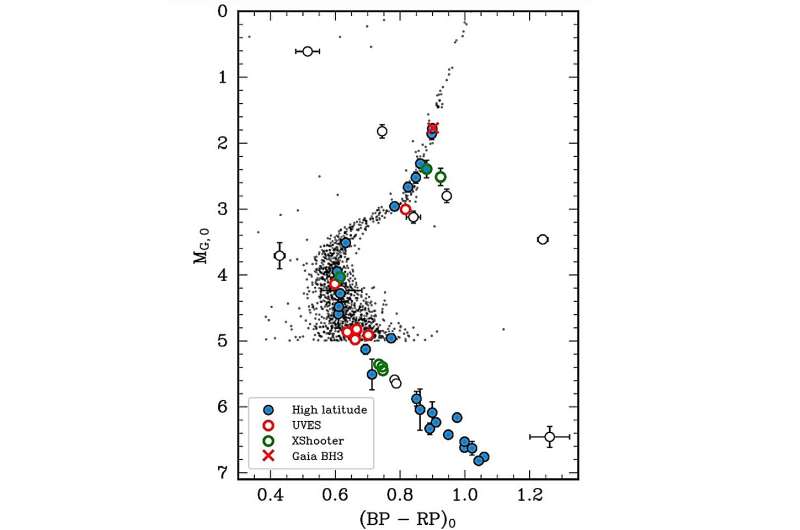April 25, 2024 report
This article has been reviewed according to Science X's editorial process and policies. Editors have highlighted the following attributes while ensuring the content's credibility:
fact-checked
preprint
trusted source
proofread
Recently discovered black hole is part of a nearby disrupted star cluster, study finds

European astronomers have investigated a recently detected black hole designated Gaia BH3. In their results, they found that the black hole is associated with a nearby disrupted star cluster known as ED-2. The finding is reported in a paper published April 17 on the preprint server arXiv.
At a distance of some 1,900 light years, Gaia BH3 is a black hole discovered in April 2024 in a wide binary system within the galactic halo. It has a mass of about 33 solar masses, which makes it the most massive black hole of stellar origin known in our galaxy. The black hole's visible companion is an old, very metal-poor giant star, about five times larger than the sun, with a mass of approximately 0.76 solar masses. The system has a period of 11.6 years.
ED-2 is a disrupted old star cluster, which is now a galactic halo stellar stream. It is a dynamically cold stream crossing the solar neighborhood. The mean metallicity of ED-2 stars is estimated to be at a level of −2.60.
A team of astronomers led by Eduardo Balbinot of the University of Groningen in the Netherlands has investigated chemical abundances of ED-2 member stars and orbital characteristics of the Gaia BH3 binary. The obtained results indicate that Gaia BH3 belongs to the ED-2 stellar stream.
"We find that the galactic orbit of the Gaia BH3 system and its metallicity are entirely consistent with being part of the ED-2 stream," the researchers wrote in the paper.
The study found that the orbit of the black hole Gaia BH3 around the galaxy is indistinguishable from that of ED-2 member stars. It also turned out that only 17% of ED-2 members are closer to the galactic center than Gaia BH3.
The mean metallicity of the giant star in Gaia BH3 was found to be −2.56, which is close to the mean metallicity of stars in ED-2. Moreover, chemical elemental abundances such as magnesium, europium and barium-to-iron ratios of ED-2 members are consistent with that of the black hole's companion.
Therefore, according to the authors of the paper, these findings confirm that Gaia BH3 is unambiguously associated with the ED-2 stream.
The collected data also allowed the astronomers to shed more light on the formation of Gaia BH3 and ED-2. The results suggest that the progenitor of Gaia BH3 formed more than 13 billion years ago, and that the parent system of ED-2 was a small cluster with a mass smaller than 42,000 solar masses.
"This implies that the black hole could have formed directly from the collapse of a massive very-metal-poor star, but that the alternative scenario of binary interactions inside the cluster environment also deserves to be explored," the researchers concluded.
More information: E. Balbinot et al, The 33 M⊙ black hole Gaia BH3 is part of the disrupted ED-2 star cluster, arXiv (2024). DOI: 10.48550/arxiv.2404.11604
Journal information: arXiv
© 2024 Science X Network





















